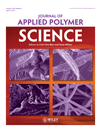Water absorption and dimensional stability of short kenaf fiber-filled polypropylene composites treated with maleated polypropylene
Abstract
The purpose of this research was to investigate the water absorption behavior and associated dimensional stability of kenaf-polypropylene-filled (PP/KF) composites. Composites with different fiber loadings, ranging from 0 to 40 wt %, were prepared with a twin-screw extruder followed by hot press molding. The influence of the compatibilizer was also studied for PP/KF composite with 5 wt % maleated PP (MAPP). Water absorption testing was carried out at room temperature for 7 weeks. Tensile, flexural, and impact tests were also performed on control, wet, and re-dried specimens. Increasing the fiber content resulted in higher water absorption and thickness swelling. The inferior mechanical properties of the wet composites were attributed to the effect of water, which deteriorates the interfacial properties of composites. On re-drying, all properties were almost recovered because of the recovery of interfacial area as evident in scanning electron micrographs. Incorporation of the MAPP significantly improved the compatibility between the fiber and matrix and the mechanical properties of the composites compared with those without MAPP. It also diminished the water absorption as well as the related thickness swelling in the composites. © 2010 Wiley Periodicals, Inc. J Appl Polym Sci, 2010




